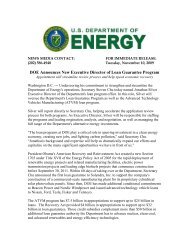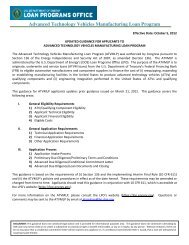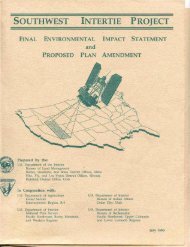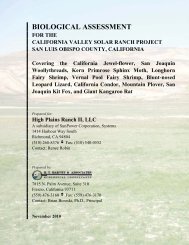Bureau of Land Management's Decision Record and Environmental
Bureau of Land Management's Decision Record and Environmental
Bureau of Land Management's Decision Record and Environmental
You also want an ePaper? Increase the reach of your titles
YUMPU automatically turns print PDFs into web optimized ePapers that Google loves.
Jersey Valley Geothermal Development Project<br />
<strong>Environmental</strong> Assessment: NV063-EAO8-091<br />
Suitable habitat may be present within the surveyed portions <strong>of</strong> the Jersey Valley Unit Area,<br />
however no individuals were observed during the field survey (GBE 2008). Habitat may also be<br />
present along portions <strong>of</strong> the transmission line corridor, however the season long grazing on this<br />
area has reduced the plant diversity over time <strong>and</strong> this species was not observed during the field<br />
survey (GBE 2008).<br />
Reese River Phacelia<br />
Reese River Phacelia habitat is open, dry to moist, alkaline, nearly barren, sometimes scree<br />
covered, whitish to brownish shrink-sell clay soils derived from fluviolacustrine volcanic ash <strong>and</strong><br />
tuff deposits, generally on the steeper slopes <strong>of</strong> low hills, bluffs, <strong>and</strong> badl<strong>and</strong>s in the<br />
shadscale-greasewood, sagebrush, <strong>and</strong> lower pinyon-juniper zones with A triplex confertifolia,<br />
A canescens, Artemisia tridentate, Sarcobatus vermiculatus, tetradym Ia, Phacelia gymnoclada,<br />
Cleomella, etc (NNHP 2001b).<br />
Suitable habitat may be present within the surveyed portions <strong>of</strong> the Jersey Valley Unit Area,<br />
however no species were observed during the field survey (GBE 2008). No Reese River Phacelia<br />
populations were observed along the transmission line corridor (GBE 2008).<br />
Sadaspyrg <strong>and</strong> Dixie Valley pyrg<br />
The Sadas pyrg (Pyrgulopsis sadai) <strong>and</strong> Dixie Valley pyrg (P. dtrensis) are both springsnails<br />
associated with freshwater seeps <strong>and</strong> springs. While the springs occupied by springsnails vary in<br />
their water quality <strong>and</strong> quantity, generally speaking, the springs need to be perennial, have<br />
moderate to high flows, cool temperatures, <strong>and</strong> good water quality. Springs that have been<br />
developed or heavily impacted by livestock, wild horses, or wildlife, are not as likely to have<br />
springsnails as springs with good water quality <strong>and</strong> riparian vegetation (GBE 2008).<br />
The perennial water sources within the Jersey Valley Unit Area consisted <strong>of</strong> two springs, neither<br />
possesses cool water <strong>and</strong> flows were very low. Additionally, both springs were impacted by wild<br />
horses <strong>and</strong> livestock <strong>and</strong> did not appear to be suitable habitat for springsnails. No springsnails<br />
were observed within either spring (GBE 2008). No perennial waters occurred along the<br />
transmission line corridor, <strong>and</strong> therefore, no suitable habitat for the springsnalls existed (GBE<br />
2008).<br />
Western burrowing owl<br />
Western burrowing owls inhabit open terrain <strong>and</strong> typically create a nest by occupying an<br />
ab<strong>and</strong>oned burrow created by other animals such as a badger (Taxidea taxus). They are also<br />
found in roadside berms (Stamm 2006).<br />
Burrowing owl habitat is marginal within the surveyed portions <strong>of</strong> the Jersey Valley Unit Area.<br />
One historically active burrowing owl nest exists within 1 mile <strong>of</strong> the proposed transmission<br />
corridor thus surveys were completed specific to this species. Numerous burrows were observed<br />
during GBE’s 2008 survey, but no sign <strong>of</strong> burrowing owl activity was observed. The survey was<br />
- 47 -







